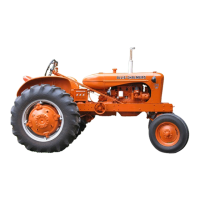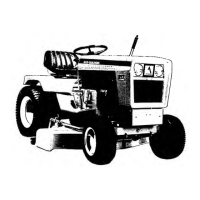Do you have a question about the Allis-Chalmers HD 6B and is the answer not in the manual?
Description of the Model HD 6B Tractor.
Explains how power is transmitted from the engine.
Details operator comfort and positive control features.
Lists standard components of the tractor model.
Provides physical dimensions and approximate shipping weight.
Details track shoe width and tread width.
Lists engine make, model, type, and specifications.
Describes steering method and turning radius.
Lists approximate fluid capacities for various systems.
Outlines speeds at rated engine speed for different gears.
Identifies where the tractor serial number is stamped or located.
Identifies where the engine serial number is located.
Recommends non-corrosive diesel oil and viscosities.
Specifies using same oil as crankcase, cautioning against foam.
Recommends good grade engine oil for these assemblies.
Specifies grease for wheels, idlers, and rollers.
Details lubricant requirements for pressure guns.
Details required fuel properties for ignition and burn.
Explains cetane number and diesel index for ignition.
Importance of volatility and avoiding contaminants.
Need for fuel lubricity and handling precautions.
Stresses preventing contamination to protect engine parts.
Discusses using portable tanks for jobsite storage.
Recommends settling fuel and proper drum usage.
Advises filling tank at end of day to reduce condensation.
Emphasizes lubrication's importance for longevity.
Recommends services to prevent failures and ensure operation.
Lists tasks for every 10 hours of operation.
Lists tasks for every 100 hours of operation.
Lists tasks for every 200 hours of operation.
Lists tasks for every 400 hours of operation.
Lists tasks for every 1000 hours of operation.
Lists general periodic maintenance actions.
Lists periodic adjustments needed.
Pre-operation checks and filling fluids.
Locating and lubricating key fittings.
Adjusting tracks after transit.
Maintaining 160°-185° F for efficiency.
Checking bolts after first 10 hours of use.
Importance of checking stud nut tightness.
Description of various control levers and pedals.
How to start and stop the engine using the knob.
Correct use of the starter rod.
Adjusting engine speed with the throttle.
Engaging and disengaging the engine clutch.
Selecting appropriate gear ratios.
Controlling tractor direction with steering levers.
Using brake pedals for speed control and turning.
Securing the brake pedals in applied position.
Purpose of the starting fluid dispenser.
How to operate the primer pump.
Function of the light switch.
Description of temperature, oil pressure, fuel gauges.
Explains ammeter and engine hour meter readings.
Step-by-step guide to starting the engine.
Verifying fuel, oil, coolant, and bolt tightness.
Proper procedure after engine starts.
Checking vital fluid pressures.
Using starting fluid in cold conditions.
Specific instructions for using the primer in cold.
Correct method to stop the engine.
Explains negative effects of prolonged idling.
Advises stopping the engine when not in use.
Steps to start the tractor and warm it up.
Proper clutch operation and gear shifting.
Importance of choosing the right gear for loads.
Function and engagement of the engine clutch.
How to steer the tractor using levers.
How to measure steering lever free play.
Technique for making sharp turns.
Steering considerations on downhill slopes.
Steps for safely stopping the tractor.
Protecting compartments from contaminants.
Draining accumulated oil/water.
Adjusting fluids and preparing cooling system.
Using primer and radiator covers for cold starts.
Ensuring batteries and electrical components are functional.
Special equipment and cautions for extreme cold.
Details the parts of the cooling system.
Maintenance for warm and winter seasons.
Procedure for completely draining the system.
Steps to properly fill the cooling system.
Completing the cooling system filling process.
How to adjust the fan drive belts.
Adjusting the belt for these components.
Overview of the fuel system's parts.
Components of the low pressure fuel circuit.
Components of the high pressure fuel circuit.
Describes how fuel moves through the system.
Details on the heavy-duty injection pump operation.
Explains the function of fuel nozzles.
Servicing the fuel tank and drain.
Explains first and second stage filters and their service.
Step-by-step guide for replacement.
Step-by-step guide for replacement.
Maintenance for the heavy-duty filter.
Steps for replacing the heavy-duty element.
Diagnosing air intrusion issues.
Diagnosing blockages in filters or lines.
Diagnosing an inoperative transfer pump.
Diagnosing an inoperative relief valve.
Diagnosing inoperative fuel nozzles.
Diagnosing an inoperative injection pump.
Detailed steps to check for air admission.
Detailed steps for filter/line clog diagnosis.
Procedures to check transfer pump and relief valve.
Methods to identify faulty fuel nozzles.
Steps to determine if the injection pump is at fault.
Procedure for testing and adjusting fuel nozzles.
Steps for safely removing a fuel nozzle.
Verifying spray pattern and popping pressure.
Steps for correctly installing a fuel nozzle.
Steps to remove the fuel injection pump.
Aligning timing marks for engine and pump.
Continued steps for pump removal.
Procedures for bleeding air from fuel lines.
Steps to install the fuel injection pump.
Completing the pump installation process.
Bleeding air from the fuel system components.
Procedure for venting the high pressure system.
Explains the governor's purpose and factory settings.
How to verify engine idle and high speed settings.
Steps to adjust low and high idle engine speeds.
Explains the pressurized lubrication system.
Description and replacement of the oil filter.
Steps for replacing the heavy-duty oil filter element.
Description of the 24-volt system components.
Checking battery electrolyte levels.
Readings for satisfactory condition and freezing points.
Maintenance for generator and regulator.
Adjusting the drive belt for these components.
Information on starter operation and recommended service.
Checking for loose connections and frayed insulation.
Explains how cleaners protect the engine.
Steps to empty and clean the air pre-cleaner.
Completing the pre-cleaner service.
Cleaning and refilling the air cleaner oil cup.
Why a primer is needed in cold conditions.
Components of the cold weather primer.
Troubleshooting a clogged primer elbow.
Identifying reasons for primer pump failure.
Steps to replace worn piston rings.
Details on primer pump check valves.
How to clean the dispenser strainer.
Explains why correct valve lash is critical.
Step-by-step guide to adjusting valve lash.
Why maintaining stud nut torque is crucial.
Steps for correctly torquing cylinder head studs.
Procedures for removing, cleaning, and inspecting energy cells.
How to adjust the engine shut-off linkage.
How to adjust the throttle control linkage.
Completing the throttle linkage adjustment.
Details on the single-plate dry clutch.
When and why clutch adjustment is needed.
Steps for adjusting the Rockford clutch.
Steps for adjusting the Auburn clutch.
Final steps for Auburn clutch adjustment.
Steps to wash a clutch affected by oil or grease.
Details on the multiple disc steering clutches.
Adjusting the steering clutch control linkage.
Procedure to measure lever free travel.
Steps to adjust the linkage.
Final steps for linkage adjustment.
Procedure for cleaning steering clutches.
Explains why correct adjustment is vital.
Steps to adjust the steering brakes.
Completing the steering brake adjustment.
How to achieve correct track tightness.
Checking and adjusting track idlers for wear.
Tasks before storing the tractor.
Preparing engine and fuel systems for storage.
How to store batteries during periods of inactivity.
Preparing the cooling system for storage.
| Manufacturer | Allis-Chalmers |
|---|---|
| Model | HD 6B |
| Engine Manufacturer | Allis-Chalmers |
| Rated RPM | 1600 |
| Starter | Electric |
| Hydraulic System Type | Open center |
| Engine Type | Diesel |
| Bore/Stroke | 108mm x 127mm |
| Cooling | Liquid-cooled |
| Transmission Type | Gear |
| Fuel Tank Capacity | 25 gal (94.6 L) |
| Fuel Capacity | 25 gal (94.6 L) |
| PTO Horsepower | Not available |












